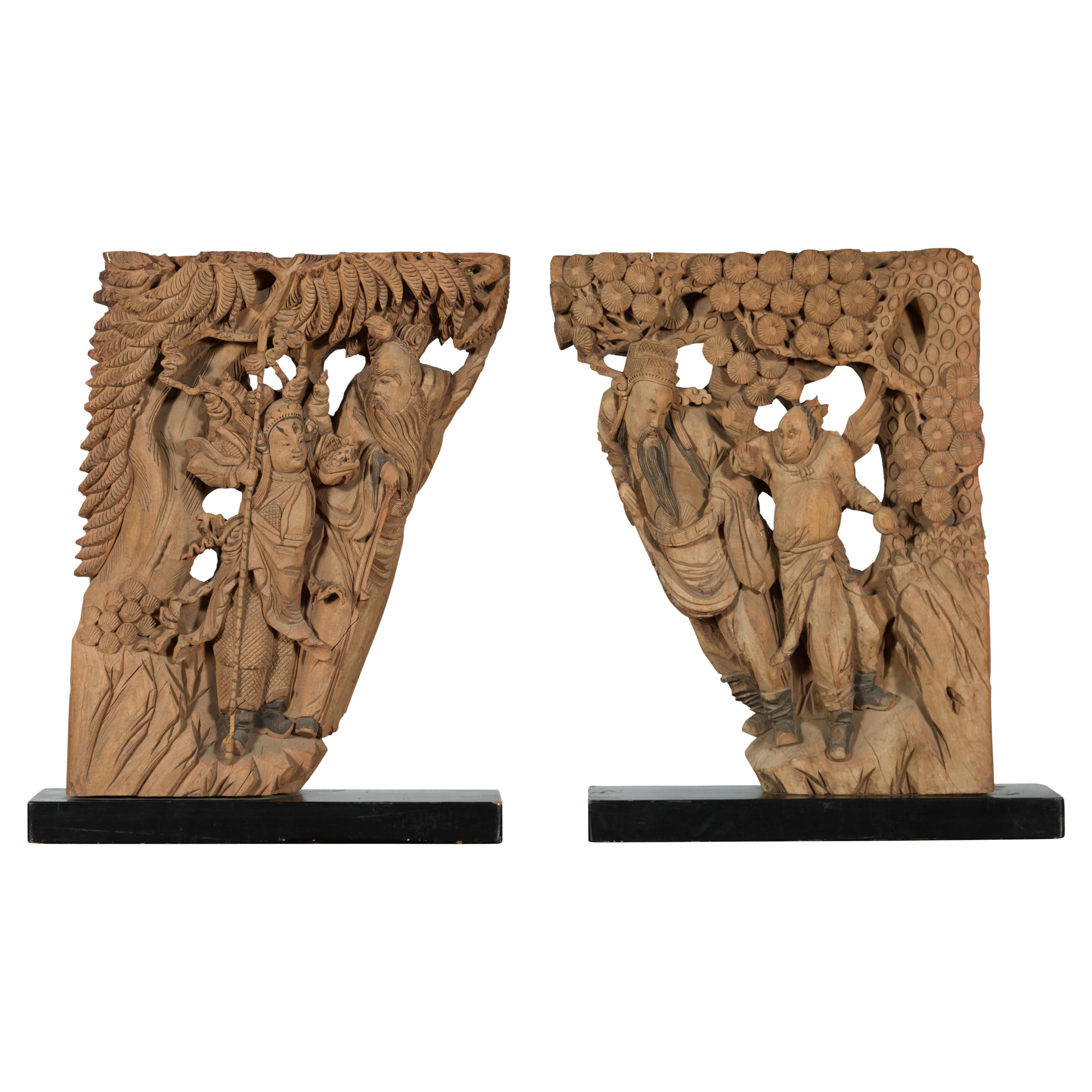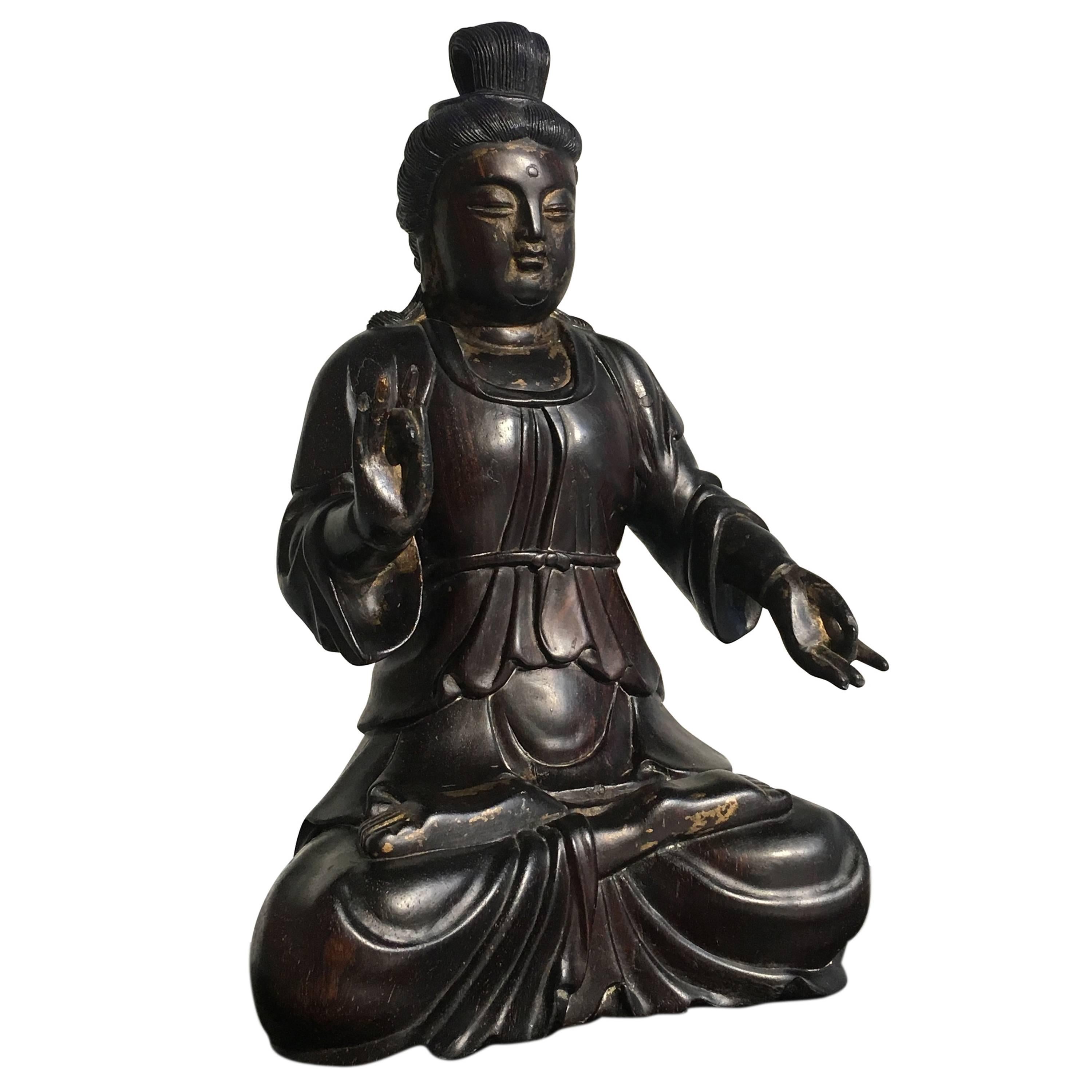Items Similar to Pair of Qing Dynasty Hand-Carved Wooden Temple Corbels with Deer Motifs
Want more images or videos?
Request additional images or videos from the seller
1 of 17
Pair of Qing Dynasty Hand-Carved Wooden Temple Corbels with Deer Motifs
About the Item
A pair of Chinese Qing Dynasty hand-carved wooden temple corbels from the 18th or 19th century with deer and their young. Originally part of a temple wall, this pair of Chinese corbels from the Qing Dynasty (or earlier), features two deer facing one another and showcasing very dynamic postures. Surrounded by detailed foliage, their back paws still resting on a rocky formation, the deer have textured bodies and antlers. Upon closer inspection, one will notice the baby deer looking lovingly upwards. With their skillfully carved scene and natural finish, this pair of Qing Dynasty temple corbels will be excellent decorative additions to any home!
- Dimensions:Height: 29 in (73.66 cm)Width: 17 in (43.18 cm)Depth: 5.5 in (13.97 cm)
- Sold As:Set of 2
- Style:Qing (Of the Period)
- Materials and Techniques:
- Place of Origin:
- Period:
- Date of Manufacture:18th or 19th Century
- Condition:Wear consistent with age and use. Age appropriate wear and maintenance. Please refer to the various additional photos for further condition detail and contact us with any questions!
- Seller Location:Yonkers, NY
- Reference Number:
About the Seller
5.0
Platinum Seller
These expertly vetted sellers are 1stDibs' most experienced sellers and are rated highest by our customers.
Established in 1968
1stDibs seller since 2009
921 sales on 1stDibs
Typical response time: <1 hour
- ShippingRetrieving quote...Ships From: Yonkers, NY
- Return PolicyA return for this item may be initiated within 3 days of delivery.
More From This SellerView All
- Chinese Qing Dynasty Hand-Carved Wooden Temple Corbel with Detailed FiguresLocated in Yonkers, NYA Chinese Qing Dynasty period hand-carved wooden temple corbel from the 19th century with detailed figures and custom base. Created in China during the ...Category
Antique 19th Century Chinese Qing Mounted Objects
MaterialsWood
- Pair of 19th Century Chinese Qing Dynasty Hand-Carved Wooden Temple CorbelsLocated in Yonkers, NYA pair of Chinese Qing Dynasty period hand-carved temple corbels from the 19th century, mounted on black bases. Created in China during the Qing Dynasty...Category
Antique 19th Century Chinese Qing Figurative Sculptures
MaterialsWood
- Pair of Chinese 19th Century Hand Carved Wooden Temple Corbels with WarriorsLocated in Yonkers, NYA pair of Chinese Qing Dynasty hand carved temple corbels from the early 19th century, depicting warriors. Created in China during the Qing Dynasty, thi...Category
Antique 19th Century Chinese Qing Mounted Objects
MaterialsWood
- Qing Dynasty Chinese 19th Century Stone Temple Pedestal with Hand-Carved MotifsLocated in Yonkers, NYA Chinese Qing Dynasty period stone temple pedestal from the 19th century with hand-carved motifs. Created in China during the Qing Dynasty, this temple pedestal features a linear si...Category
Antique 19th Century Chinese Qing Architectural Elements
MaterialsStone
- Antique Chinese Hand Carved Temple Corbel with Original Red PolychromyLocated in Yonkers, NYAn antique Chinese hand carved wooden temple corbel from the 19th century, with characters, pagodas, vegetation and red polychromy. This Chinese archite...Category
Antique 19th Century Chinese Sculptures and Carvings
MaterialsWood
- Chinese Shanxi 1840s Hand Carved Wooden Corbel with Deities Mounted on BaseLocated in Yonkers, NYA Chinese Shanxi carved wooden corbel from the mid 19th century, mounted on a base and depicting two deities. Born in the Northern Province of Shanxi during the 1840s, this exquisite wooden corbel demonstrates the undeniable skill Chinese artists possessed at the time. Presenting two deities (possibly Zhong...Category
Antique Mid-19th Century Chinese Qing Sculptures and Carvings
MaterialsWood
You May Also Like
- Chinese Carved Zitan Figure of a Bodhisattva, Qing DynastyLocated in Austin, TXA finely carved Chinese zitan wood figure of an unidentified bodhisattva, possibly Guanyin, late Qing Dynasty, circa 1900, China. The androgynous figure has a plump, almost matronly face, with downcast eyes and a gentle smile. The hair in long tresses, gathered and tied in a high chignon. The enlightened being is portrayed seated in dhyanasana, bare feet resting on crossed legs, both soles pointing up. Thick robes billow and drape around the full figured body. The hands display...Category
Early 20th Century Chinese Qing Sculptures and Carvings
MaterialsLapis Lazuli
- Chinese Carved Boxwood Figure of Guanyin, Mid-Qing DynastyLocated in Austin, TXA sublime Chinese carved boxwood figure of the Bodhisattva of Compassion, Avalokiteshvara, called Guanyin in Chinese, mid-Qing dynasty. The an...Category
Antique Late 18th Century Chinese Qing Sculptures and Carvings
MaterialsBoxwood
- Chinese Carved Bamboo Figure of a Sage, Qing Dynasty, 18th CenturyLocated in Austin, TXA sweet and lovely Chinese bamboo carving of the sage Dongfang Shuo, mid-Qing dynasty, 18th century, China. Well carved form a single section o...Category
Antique 19th Century Chinese Qing Sculptures and Carvings
MaterialsBamboo
- Chinese Qing Dynasty Carved Bamboo HeHe ErXian Group, 19th CenturyLocated in Austin, TXA wonderful Chinese bamboo figural carving featuring the Taoist immortal twins of eternal youth, known as the HeHe ErXian, Qing dynasty, 19th century. F...Category
Antique 19th Century Chinese Qing Sculptures and Carvings
MaterialsBamboo
- Large Chinese Carved and Lacquered Buddha, Qing Dynasty, 19th CenturyLocated in Austin, TXA large and magnificent near life-sized Chinese carved and lacquered wood figure of a Buddha, Qing Dynasty, 19th century or earlier, southern China. The figure likely represents one of the Five Tathagatas, also known as Dhyani Buddhas or Wisdom Buddhas. More specifically, either Amitabha or Amoghasiddhi. Amitabha is the Buddha of infinite light, and represents the wisdom of observation and recognition. Amoghasiddhi is the Buddha of accomplishment, and represents the wisdom of perfected practices. The size and scale of the Buddha indicates it was made for temple worship. The large Buddha is portrayed seated in vajrasana, or full lotus position, with the soles of both feet facing up. His elegant hands, with impossibly long and slender fingers, perform shuni mudra, the gesture of bestowing patience. His right arm is bent at the elbow, the right hand raised to heart level. The left arm resting gently in his lap, the left hand at navel level. The Buddha is dressed in voluminous robes that wrap around his shoulders and body, and tied at the waist. The heavy fabric draping and pooling elegantly all around his robust body. His broad chest and right arm exposed. The Buddha's face is both solemn and beatific - his expression seeming to change depending on the angle of view. The most notable feature of his face is the large urna to the center of his forehead, set between a pair of painted, high arching brows over heavily lidded almond shaped eyes. A strong nose is set above a small mouth pursed in an ever so slight smile. Long pendulous earlobes touch his shoulders. The Buddha's hair arranged in the typical fashion, with "spikes" representing tight curls. A prominent ushnisha rises from the crown of his head, covered by more hair, and topped with a rounded protuberance. The Buddha is constructed from several blocks of wood, joined, carved and lacquered a deep red-brown with gold flecks...Category
Antique 19th Century Chinese Qing Sculptures and Carvings
MaterialsWood
- Gilt Bronze Figure of Xi-Wang-Mu, Qing Dynasty, Qianlong KingdomLocated in Torino, ITThe queen mother of the west is cast in a seated position with her hands held before her chest holding a "gui". She is dressed in long-sleeved robes. Her face is framed by an elabora...Category
Antique 1790s Chinese Qing Sculptures and Carvings
MaterialsBronze
Recently Viewed
View AllMore Ways To Browse
Deer Wood
Wooden Surround
Carved Deer
Carved Antler
Baby Animal
Chinese Wooden Sculptures
Chinese Wooden Sculpture
Carved Wood Antler
Hand Carved Chinese Wooden
Carved Wood Temple
Chinese Temple Sculpture
Wood Chinese Temple
Hand Carved Wooden Animals
Wood Deer Antlers
Wooden Temple
Antique Wooden Showcase
Hand Carved Corbels
Wood Carved Animals Pairs





